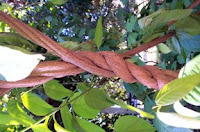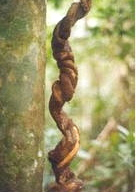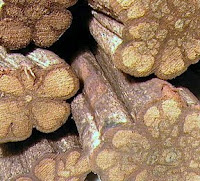As I have said before, the shaman can see things that people who are not shamans cannot. The shaman may be able to find lost objects, know where game is plentiful, discern who has cast a curse, diagnose the location or cause of an illness. Many scholars, influenced by the work of Mircea Eliade, maintain that the characteristic activity of shamanism is soul flight — celestial ascent, ecstasy, out-of-body journeys to the spirit realm, almost always vertically, upwards, toward the sky. And it is true that, among some shamanic traditions, out-of-body flight is the way that shamans acquire the information that is their stock in trade. They travel through the air and go look.
 |
Shamanism in the Upper Amazon is, I think, different.
As we have seen, mestizo shamans summon the protective and healing spirits to the place of ceremony by singing the appropriate icaros, magical songs, and receive from them, often in strange or secret languages, information regarding the diagnosis and treatment of their patients. Thus, the locus of their interaction with the spirits is not the spirit realm, to which the shaman travels, but rather the place where the shaman conducts the ceremony.
This general rule applies even when shamans are retrieving a soul lost through susto or manchari, or retrieving a person physically stolen away by the spirits of the underwater realms, the mermaids or yacuruna, the water people. They do not journey in pursuit of the soul; rather, they summon the soul back to the body it had inhabited, or summon and coerce the people of the waters to bring the stolen person back to the place of ceremony, using the icaros they have learned from the plant spirits or, indeed, from the water people themselves.
 |
Drinking ayahuasca can give visions of distant people and events. These visions can give both shaman and patient information about the location of a lost object, the health of a distant relative, the face of a secret enemy, the seducer of a spouse. Such visions encompass past and future as well: my teacher doña María Tuesta saw in her visions how her brothers had died, both murdered years before, one in a robbery and one in a drunken brawl. Indeed, people may come to a healing ceremony and drink ayahuasca simply to gather such information — the welfare of a traveling relative, the seducer of a spouse, the location of a stolen water pump.
Shamans get just this sort of information from ayahuasca — and more. They can see what is happening on distant planets and galaxies, where in the underwater realm a kidnapped fisherman is being held captive, the mountain cave in which a stolen soul is hidden, what the doctors at vast spiritual hospitals have to say about a patient’s condition. Among the Cashinahua, too, ayahuasca is taken with the intent to get information about distant places and their beings, the hiding places of game, the real intentions of opponents in conflicts, the motives of visitors, future events, and the causes of sickness.
 |
We should not assume, based on our own cultural preferences, that this information is only or always conveyed visually. Consistent with the role of the auditory in the jungle environment, such information can be conveyed verbally. Thus, Aguaruna shamans are able to know events that are distant in space and time; they do this, not by traveling themselves, but because their pasuk spirits bring them information from faraway places. The same is true for mestizo shamans: the etiology of a patient’s illness — the source of the pathogenic object, the identity of the sorcerer who projected it, the faithless spouse or false business partner or offended stranger who instigated the attack — can be whispered audibly, with startling clarity, into the ear of the shaman by the plant spirits who are in attendance at the healing.
Thus, shamans do not drink ayahuasca to heal; they drink ayahuasca to get information — as Cocama shaman don Juan Curico puts it, “to screen the disease and to search the treatment.” Mestizo shaman don Manuel Córdova says the same thing: “Ayahuasca, it tells you how, but by itself it cures nothing.”

- Previous Post: Shamans and Herbalists
- Next Post: Virotes
- More Articles Related to: Ayahuasca, Shamanism



I think what you have written here is tremendous. As momentum builds in our western culture to seek out these substances and ceremonies, it often seems to me that we simply often want the ayahuasca itself without the understanding of its traditional use. Somewhat arrogant I think as these people have been using it for thousands of years and westerners in force since when? Burroughs in the Yage letters? I myself want ot try this substance for what may be the “wrong reasons”. Am I acutely ill? No. Do I need any specific information? not thatI can think of. In my heart of hearts, I sometimes view entheogens as magic bullets, or hope that they will be such to counteract what I can only describe as a western cultural isolating malaise. But I also know that there is no substitute for actual work.
I agree that some gringos seek to use the medicine to heal their troubles — often self-inflicted — without doing any actual work.
My older brother Chuntaro, in one of his comments, says that people who think that just the ceremony and the medicine will heal their emotional, relationship, and psychological issues, without any work on their part, are not being honest with themselves, and are just looking for an excuse to not get better. That sounds right to me.
Still, I was told that there is nothing wrong with seeking to learn the medicine — trying to deepen a relationship with la diosa and the other sacred and healing plants, by sitting in their company and letting them teach what they will.
Much pleased am i to read about ayahuasca.
Because i have been using psilocybine mushrooms
for many years,and have come to know the wisdom of the amazonian shamans a highly valuable one
in the integration my understanding of the shamanic use.
Mushrooms have shown me my inner potential to be who i am beyond self programmed fears.
That is like having ones path enlightened from above and below.
The truth shall set us free.
Thank you very much
plants.
You’re very welcome.